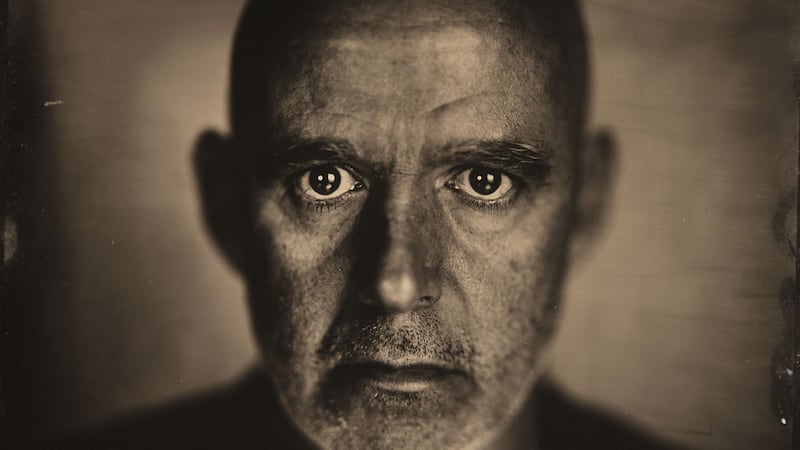I’m told to sit in a chair just inches away from a large and intimidating wooden box with a weird looking bellows attached to its back, and ordered not to move, under any circumstances.
"It is okay if you breath, and you can blink a little, but nothing else, okay?" The order comes from Alex Sapienza, an accomplished television cameraman and the owner of a Dublin photographic studio which uses technology that is more than 150 years old to capture 21st moments.
Based on South William Street, his Analogue Studio is – unsurprisingly – Ireland’s only 19th century photography studio specialising in wet plate photography to create images on glass and aluminium.

He focuses a lens dating from the 1860s onto my eyes and starts a countdown. “I am going to go from three to one and when I start counting, you can’t blink either,” he warns me.
It is amazing how being told you can’t blink makes you want to blink. A lot. I stare into the lens as he inserts the aluminium plate into the back of the wooden box. “Once the plate goes in, I won’t be able to see you, so I’m relying on you not moving,” he says. “If you move, the picture will be ruined.”
No pressure.
He starts the countdown. Three. Two. One. It seems endless. I don’t move. Suddenly there is an explosion of light. I blink, obviously. But not before the image is captured. While the camera is ancient, relatively speaking, the lighting Sapienza uses is more modern and the exposure time needed to capture my face on the plate is much shorter than it used to be back in the day, so I only had to stay sill for a couple of seconds.
Rewind to the 1850s and it was a different story.
One of the more striking things about photographs taken in the 19th century and the early part of the last century is how serious everyone seemed to be. Think of all the sepia-toned photographs you have ever seen and try to recall even one in which the subject was smiling, or grinning, or giving any indication that life was something other than a grim ordeal to be endured rather than enjoyed.
There are none. Or at least very few.
Sapienza explains why. “Back then, they used continuous lighting for exposures. Every exposure would probably have been about 30 seconds long,” he says.
“It is not possible to hold a smile for that long and people weren’t allowed to move when the pictures were being taken. They knew that if they did, the shot would be ruined,” he says. “And it cost a lot of money to get a picture taken back then.”
There is another reason why people in the 19th century didn’t smile on camera – or at least why the class of person who could afford to get their picture taken never seemed to. “Smiling was seen as a working class thing, something expected of drunks and clowns,” Sapienza says. “Wealthy people wanted to distance themselves from people like that so they never smiled, at least not for photographs.”
How dull the world must have been for such folk then. And how much it has changed. Today, we are all wild smiles as we pose for endless selfies before tweaking them with all manner of filters to make ourselves look better, or cooler, or more interesting, ahead of posting them on Instagram or Facebook or whatever social media platform you are having yourself.
We are without question the most photographed and most photographing generation in the history of the world. The power of the smartphone means that almost everyone – 86 per cent of Irish people, according to a recent survey from Deloitte – has a high resolution digital camera with them at all times.
All the smartness and all the platforms we can put our pictures on means we constantly document our animals and children doing cute of things, our dinners, and our feet as we put them up in front of the telly on a damp Tuesday evening.
There is literally nothing we don’t think is worth taking a picture of nowadays.
So, what place does this old technology have in our world? And how on earth does he keep the equipment running after all these years?
Sapienza answers the second part of the question first. “It is just a box with a lens really. There aren’t as many moving parts as you’d find in a modern camera, so once you know what you’re doing, keeping it going is not hard”.
He has a ready answer for the first part of the question too. “There is something timeless about these analogue photographs, something unique that can’t be recreated digitally. These are a one-off thing which capture single moments in time. And they capture those moments with all their imperfections and all their flaws. A lot of modern photography seeks to remove the imperfections but that is what gives character and it is what makes us who we are.”
He is not, however, some class of latter-day luddite and also uses digital technologies, both in his professional life and when he is taking pictures and uploading them to Instagram. “I don’t believe if you do analogue photography that you can’t do digital photography as well, or that analogue is good and digital is bad,” he says.
Sapienza started exploring the analogue world in depth in 2012, and when work in his normal medium started to become scarce as production companies and television stations tightened purse strings and pulled back on productions, he decided to develop another skill.
“I did a workshop in analogue in Manchester,” he says, as he carries the plate carrying my likeness into his darkroom. “It was only a weekend workshop, but I fell in love and with the process.”
He puts the plate into a sink and adds chemicals to it. The negative of my face looks like it belongs on the Shroud of Turin. He pours more chemicals on and within seconds the negative turns to a positive. It’s kind of spooky to watch your image appear under a running tap. The eyes appear first. And then the rest of my face.
The picture looks amazing. To be clear, I do not think the picture looks amazing because I am in it. It is the process and the uniqueness and the permanence of it that amaze me. Sapienza has taken pictures of Mel Gibson, Adam Clayton and a whole host of other people, and all the outcomes are equally stunning.
Looking at the photograph, it is almost as if my soul has been exposed. I look scared and sad – or, as a somewhat unkind colleague said, like a serial killer. Sapienza seems pleased with my face on the plate. “I love the fact that there is texture and there are imperfections and freckles and wrinkles,” he says.
Okay, steady on, I think. There aren’t that many wrinkles.
“No, this is what photography should be about. It is an imperfect medium. We have grown used to polished pictures but I think photography should be about life and life is not perfect. Photography should be a reflection of that.”
He hands me the plate and promises it will last 150 years. I bring it home and show it to my young children. I explain to them that their children’s children’s children’s children may someday be looking at this picture and wondering who it is of.
“You look very scary,” my youngest says. “They are going to think you are terrifying.”
So, on the very off chance that my great, great, great, great grandchildren are reading these words, can I just say I wasn’t really that terrifying. Maybe I would have been better off smiling.
See theanaloguestudio.ie












